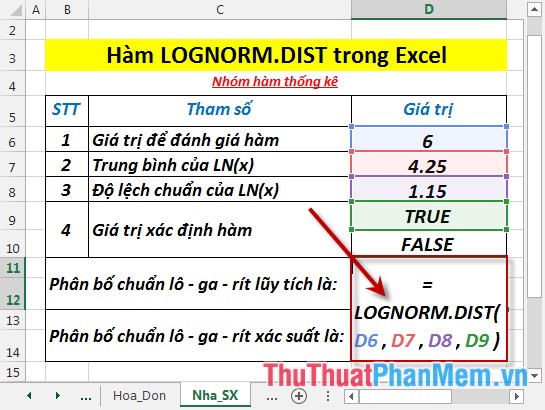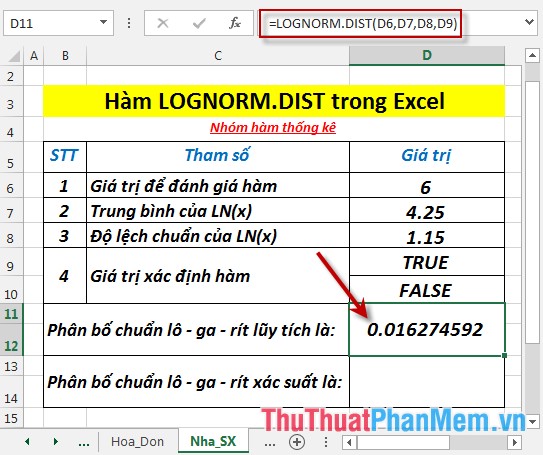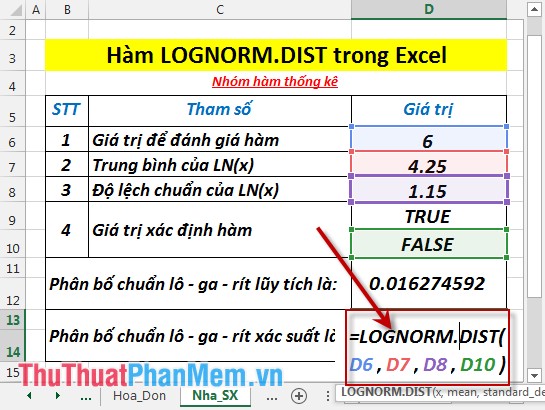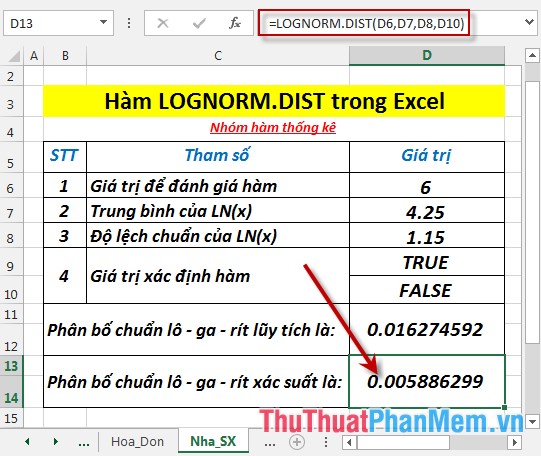LOGNORM.DIST - Function returns the logarithmic distribution of x in Excel
The following article introduces you to the LOGNORM.DIST function - one of the functions in the statistical group is very popular in Excel.

Description: The function returns the logarithmic distribution of x. Where LN (x) is usually distributed with parameter mean and standard deviation. Support functions from Excel 2010 onwards.
Syntax: LOGNORM.DIST (x, mean, standard_dev, cumulative)
Inside:
- x : Value to evaluate the function, is a required parameter.
- mean: The average value of LN (x) , is a required parameter.
- standard_dev: Standard deviation of LN (x), is a required parameter.
- cumulative: A logical value that determines the form of the function, which is a required parameter, including:
+ cumulative = True -> returns the cumulative distribution function.
+ cumulative = False -> returns the probability density function.
Attention:
- Any argument except ( cumulative) is not a number -> function returns the #VALUE! Error value
- If x ≤ 0 or standard_dev ≤ 0 -> the function returns the #NUM! Error value
- The cumulative standard logarithmic distribution equation is:
LOGNORM.DIST (x, µ, o) = NORM.S.DIST (1n (x) -µ / o)
For example:
Find the cumulative standard probability and logarithmic distribution as described in the data table below:

1. Calculate cumulative standard logarithmic distribution.
- In the cell to calculate enter the formula : = LOGNORM.DIST (D6, D7, D8, D9)

- Press Enter -> cumulative standard logarithmic distribution is:

2. Calculate probability distribution logarithm.
- In the cell to calculate enter the formula: = LOGNORM.DIST (D6, D7, D8, D10)

- Press Enter -> probability plot distribution. was:

Above are instructions and some specific examples when using the LOGNORM.DIST function in Excel.
Good luck!
You should read it
- POISSON.DIST function - The function returns the Poisson distribution in Excel
- BETA.DIST function - The function returns the Beta distribution in Excel
- T.DIST.RT - The function returns the Student's t-distribution on the right in Excel
- HYPGEOM.DIST - The function returns the hyperbolic distribution in Excel
- F.DIST - The function returns the probability distribution F in Excel
- T.DIST - The function returns the Student t-distribution on the left in Excel
- CHISQ.DIST - Function returns the distribution when squared in Excel
- T.DIST.2T - The function returns the two-tailed Student distribution in Excel
May be interested
- PHI function - The function returns the value of the density function for a normal distribution in Excel
 phi function: the function returns the value of the density function for a standard normal distribution. support functions from excel 2013 onwards. syntax: phi (x)
phi function: the function returns the value of the density function for a standard normal distribution. support functions from excel 2013 onwards. syntax: phi (x) - T.INV function - The function returns the inverse value of the Student t distribution in Excel
 t.inv: the function returns the inverse value of the student t-distribution. support functions from excel 2010 onwards. syntax: t.inv (probability, deg_freedom)
t.inv: the function returns the inverse value of the student t-distribution. support functions from excel 2010 onwards. syntax: t.inv (probability, deg_freedom) - T.DIST.RT - The function returns the Student's t-distribution on the right in Excel
 t.dist.rt: the function returns the student's t-distribution on the right. functions used in testing the hypothesis of small numbers of data sets. support functions from excel 2010 onwards. syntax: t.dist.rt (x, deg_freedom)
t.dist.rt: the function returns the student's t-distribution on the right. functions used in testing the hypothesis of small numbers of data sets. support functions from excel 2010 onwards. syntax: t.dist.rt (x, deg_freedom) - F.DIST - The function returns the probability distribution F in Excel
 f.dist function: the function returns the probability distribution f. the function supports the version from excel 2010. syntax: f.dist (x, deg_freedom1, deg_freedom2, cumulative)
f.dist function: the function returns the probability distribution f. the function supports the version from excel 2010. syntax: f.dist (x, deg_freedom1, deg_freedom2, cumulative) - HYPGEOM.DIST - The function returns the hyperbolic distribution in Excel
 hypgeom.dist: the function returns the hyperinfection distribution, using this function for problems with finite sets of vowismooix observations whether or not they are successful. syntax: hypgeom.dist (sample_s, number_sample, population_s, number_pop, cumulative)
hypgeom.dist: the function returns the hyperinfection distribution, using this function for problems with finite sets of vowismooix observations whether or not they are successful. syntax: hypgeom.dist (sample_s, number_sample, population_s, number_pop, cumulative) - F.INV function - The function returns the inverse of the probability distribution F in Excel
 f.inv function: the function returns the inverse of the probability distribution f. support function from the excel 2010 version. syntax: f.inv (probability, deg_freedom1, deg_freedom2)
f.inv function: the function returns the inverse of the probability distribution f. support function from the excel 2010 version. syntax: f.inv (probability, deg_freedom1, deg_freedom2) - F.INV.RT function - The function returns the right-inverse head value of the probability distribution F in Excel
 f.inv.rt function: the function returns the inverse of the right probability distribution f. support functions from the excel 2010 version. syntax: f.inv.rt (probability, deg_freedom1, deg_freedom2)
f.inv.rt function: the function returns the inverse of the right probability distribution f. support functions from the excel 2010 version. syntax: f.inv.rt (probability, deg_freedom1, deg_freedom2) - CHISQ.DIST - Function returns the distribution when squared in Excel
 chisq.dist: the function returns the distribution when squared, and this value is often used to understand variations as a percentage of the samples. support function from excel 2010 version. syntax: chisq.dist (x, deg_freedom, cumulative)
chisq.dist: the function returns the distribution when squared, and this value is often used to understand variations as a percentage of the samples. support function from excel 2010 version. syntax: chisq.dist (x, deg_freedom, cumulative) - T.DIST - The function returns the Student t-distribution on the left in Excel
 t.dist: the function returns the student's t-distribution on the left. functions used in testing the hypothesis of small numbers of data sets. support functions from excel 2010 onwards. syntax: t.dist (x, deg_freedom, cumulative)
t.dist: the function returns the student's t-distribution on the left. functions used in testing the hypothesis of small numbers of data sets. support functions from excel 2010 onwards. syntax: t.dist (x, deg_freedom, cumulative) - T.DIST.2T - The function returns the two-tailed Student distribution in Excel
 t.dist.2t: the function returns the two-tailed student's t-distribution. functions used in testing the hypothesis of small numbers of data sets. support functions from excel 2010 onwards. syntax: t.dist.2t (x, deg_freedom)
t.dist.2t: the function returns the two-tailed student's t-distribution. functions used in testing the hypothesis of small numbers of data sets. support functions from excel 2010 onwards. syntax: t.dist.2t (x, deg_freedom)










 LOGNORM.INV function - The function returns the inverse of the logarithmic distribution of x in Excel
LOGNORM.INV function - The function returns the inverse of the logarithmic distribution of x in Excel MAX function - The function returns the largest value in a set of values in Excel
MAX function - The function returns the largest value in a set of values in Excel MAXA function - The function returns the largest value in a set of values including text and logical values in Excel
MAXA function - The function returns the largest value in a set of values including text and logical values in Excel MEDIAN function - The function returns the median of the given numbers in Excel
MEDIAN function - The function returns the median of the given numbers in Excel MIN function - The function returns the smallest value in the given numbers in Excel
MIN function - The function returns the smallest value in the given numbers in Excel MINA function - The function returns the smallest value in the given numbers including text and logical values in Excel
MINA function - The function returns the smallest value in the given numbers including text and logical values in Excel